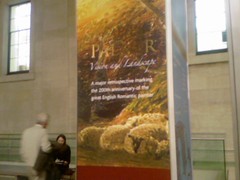The introduction to Samuel Palmer: Vision and Landscape describes the artist as “one of Britain’s greatest painters”. Certainly a couple of his works are among of the nation’s most reproduced. And this exhibition, which traces his entire career, suggests that “one of the most talented” would be a fair label. Overall, however, what is on display is a talent dissipated by the pressures of Victorian life.
The British Museum exhibition traces in detail not just his work, but his curiously modern life. A self-portrait at the age of about 19 shows a soulful young man, far too serious for his age. A Romantic, destined to die young, you would think. Yet his work at this time is conventional, picturesque landscape – one watercolors closely resembling a painting manual’s model. (Echoes of the Vettriano controversy.)
But soon he was to find a mentor. He credited the artist John Lunnell with his transformation, describing him as “a good angel from Heaven to pluck me from the pit of modern art”. A sketchbook from 1824 shows a study of “The Bad Thief”, a powerful, contorted figure menaced by a shark-mouthed Satan.
Palmer soon turned back to landscapes, but ones far from conventional, and distinctly religious. The sepia A Rustic Scene from 1828 is proto-Cubist in its detailed exploration of every head of grain, ever blade of grass, while the folds of the ploughman tunic are reminiscent of Greek sculpture. Yet the inspiration for this was medieval and early Renaissance art – the parallels here illustrated with works of the Old Masters.
He’s a painters’ painter at this time; A Cow Lodge with a Mossy Roof shows him more interested in the technical production of that fungus rather than the effect of the overall painting, in which the cows are merely sketched. There’s a fine, original talent here, and it was soon to be further developed in a rural idyll in the Kent village of Shoreham, where, with some inherited money, he was able to live the lifestyle that 140 years later would be labeled Hippie. Around him gathered acolytes known as The Ancients.
A portrait by his friend George Richmond shows how far his attempt to “resurrect the spiritual values of earlier times”, went. He has long hair and beard, and wears a medieval-style tunic. And that deep conservatism extended into politics – there’s a pamphlet in which he expressed his opposition to the Reform Act of 1832, which he thought would destroy traditional rural life. The Kent Gazette described it as: “the ravings of this maniac”.
 It was this almost frantic grasping for a rural idyll that produced his most famous painting, The Magic Apple Tree. It is also his most reproduced one, used on the exhibition’s publicity material, and I suspect, more than the odd chocolate box. A young shepherd sits beneath the fruit-laden tree with his impossibly plump, sleeping flock, the coloring rich, intense, almost golden.
It was this almost frantic grasping for a rural idyll that produced his most famous painting, The Magic Apple Tree. It is also his most reproduced one, used on the exhibition’s publicity material, and I suspect, more than the odd chocolate box. A young shepherd sits beneath the fruit-laden tree with his impossibly plump, sleeping flock, the coloring rich, intense, almost golden.
After this, however, it is all downhill. The inherited money had run out, he married Hannah, Lunnell’s oldest daughter and herself an artist (it would be nice to know more about her and her work), and his art turns distinctly commercial. If you like “nice” landscapes, then there’s plenty of pleasant views, and a fine grasp of the portrayal of light, but that’s about it.
Many might be surprised to find an “art” exhibition at the British Museum, but it boasts an extraordinary collection of prints and drawings – a fact often forgotten – and is a particularly apt for Palmer, who wrote in 1864 “our university … is that quiet printroom at the museum”. And it is an exhibition that has much to say about the context of Palmer’s Britain, taking it beyond being “just” art.
The exhibition continues until January 22. Entry is £5, with concessions.
Other verdicts: The London Review of Books, the International Herald Tribune and Telegraph.
Leave a Reply